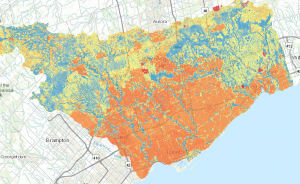Difference between revisions of "Evapotranspiration"
Jenny Hill (talk | contribs) m (→Calculation) |
Jenny Hill (talk | contribs) m (→Calculation) |
||
| Line 9: | Line 9: | ||
==Calculation== | ==Calculation== | ||
| − | [[File: TRCA_water_balance_tool.PNG|thumb|In the Toronto Region, an interactive online tool has been developed to | + | [[File: TRCA_water_balance_tool.PNG|thumb|In the Toronto Region, an interactive online tool has been developed to estimate localised precipitation and potential evapotranspiration conditions.|link=https://trca.ca/conservation/drinking-water-source-protection/trspa-water-balance-tool/]] |
===Thornthwaite Mather method=== | ===Thornthwaite Mather method=== | ||
Revision as of 17:12, 7 March 2018
Evaporation[edit]
Evaporation is the phase transfer of water into atmospheric vapour. It occurs from all wet surfaces, including the leaves of plants and damp soil. The climatic factors which influence the rate of evaporation include net radiation (i.e. sunshine), wind speed, and vapour pressure or relative humidity.
Transpiration[edit]
This is process of water being removed from the soil and being vaporised into the atmosphere by plants. Upwards flow is created within the plant tissues via osmotic potential. Water evaporates from each leaf's stomata, so that the sap becomes more concentrated. Water is drawn upwards through the stems to equalise this pressure.
Transpiration is typically able to remove water from deeper within the soil profile than evaporation. The depth will depend upon the plants root structure and depth, and its inherent transpiration rate.
Calculation[edit]
Thornthwaite Mather method[edit]
The Thornthwaite Mather method of calculating water balance[1] is recommended within the 2003 Ontario Stormwater Management Planning and Design Manual. The original paper (linked below) provides the required calculations as a series of lookup tables. The following equations are derived from these, and are widely documented elsewhere[2].
We are in the process of writing a tool to semi-automate these; please feel free request a draft copy, or to contribute your own How to contribute.
Step 1. Calculate the monthly heat index (i): where: T = mean monthly temperature.
Step 2. Calculate the annual heat index (I):
Step 3. Calculate an uncorrected Potential Evapotranspiration (PETuncorrected):
where:
Step 4. Apply a monthly correction to account for varying daylight hours and number of days in a month, to find the corrected potential evapotranspiration (PET):
Example[edit]
For the town of Richmond Hill (Lat = 43.87)
For monthly calculations, data can be found in Environment Canada Climate Normals
| Jan | Feb | Mar | Apr | May | June | July | Aug | Sept | Oct | Nov | Dec | |
|---|---|---|---|---|---|---|---|---|---|---|---|---|
| Declination (rad) | - 0.372 | - 0.232 | - 0.035 | 0.171 | 0.330 | 0.407 | 0.372 | 0.239 | 0.052 | - 0.157 | - 0.325 | - 0.407 |
| Day length (hr) | 9 | 10 | 12 | 13 | 15 | 15 | 15 | 14 | 12 | 11 | 9 | 9 |
| Temperature (°C) | - 6.20 | - 4.90 | - 0.30 | 6.90 | 13.30 | 18.70 | 21.40 | 20.30 | 15.90 | 9.10 | 3.10 | - 2.70 |
| Monthly heat index, i | 0.00 | 0.00 | 0.00 | 1.63 | 4.40 | 7.37 | 9.04 | 8.34 | 5.76 | 2.48 | 0.48 | 0.00 |
| PET (mm, uncorrected) | 0.00 | 0.00 | 0.00 | 29.91 | 62.44 | 91.50 | 106.44 | 100.33 | 76.28 | 40.80 | 12.19 | 0.00 |
| days in month | 31 | 28 | 31 | 30 | 31 | 30 | 31 | 31 | 30 | 31 | 30 | 31 |
| Corrected PET (mm) | 0.0 | 0.0 | 0.0 | 33.1 | 78.3 | 116.4 | 136.9 | 119.3 | 78.7 | 38.1 | 9.6 | 0.0 |
- ↑ Thornthwaite, C. W., and Mather, J. R., Instructions and Tables for Computing Potential Evapotranspiration and the Water Balance, Drexel Institute of Technology, Laboratory of Climatology, 1957.
 Thornthwaite1957
Thornthwaite1957
- ↑ Sellinger,C.E. Computer Program for Estimating Evapotranspiration using the Thornthwaite Method NOAA Technical Memorandum ERL GLERL-101, Great Lakes Environmental Research Laboratory 1996 [1] Accessed 8 Jan 2018





